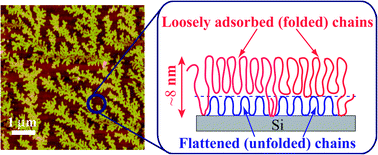Melt crystallization/dewetting of ultrathin PEO films via carbon dioxide annealing: the effects of polymer adsorbed layers
Abstract
The effects of CO2 annealing on the melting and subsequent melt crystallization processes of spin-cast poly(ethylene oxide) (PEO) ultrathin films (20–100 nm in thickness) prepared on Si substrates were investigated. By using in situ neutron reflectivity, we found that all the PEO thin films show melting at a pressure as low as P = 2.9 MPa and at T = 48 °C which is below the bulk melting temperature (Tm). The films were then subjected to quick depressurization to atmospheric pressure, resulting in the non-equilibrium swollen state, and the melt crystallization (and/or dewetting) process was carried out in air via subsequent annealing at given temperatures below Tm. Detailed structural characterization using grazing incidence X-ray diffraction, atomic force microscopy, and polarized optical microscopy revealed two unique aspects of the CO2-treated PEO films: (i) a flat-on lamellar orientation, where the molecular chains stand normal to the film surface, is formed within the entire film regardless of the original film thickness and the annealing temperature; and (ii) the dewetting kinetics for the 20 nm thick film is much slower than that for the thicker films. The key to these phenomena is the formation of irreversibly adsorbed layers on the substrates during the CO2 annealing: the limited plasticization effect of CO2 at the polymer–substrate interface promotes polymer adsorption rather than melting. Here we explain the mechanisms of the melt crystallization and dewetting processes where the adsorbed layers play vital roles.


 Please wait while we load your content...
Please wait while we load your content...